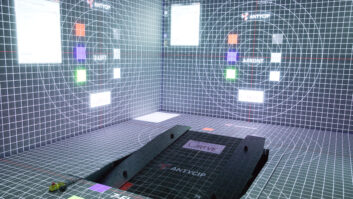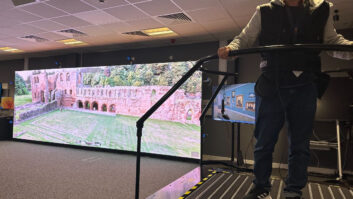
Can implementing VR really help children (and school’s) to improve their grades? AVTE chats with Veative VR Learn director of product management, Dave Dolan about the value of using VR in the classroom
“We believe VR/AR technology has the potential to be a standard tool in education and could revolutionise the way in which students are taught for the both the K-12 segment (pre college) and higher education.”
That was the view from leading global investment banking, securities and investment management firm Goldman Sachs in a recent report, discussing the value and expected demand for VR/AR technology within education over the common years.
Expectation are high and lucrative. Figures from analyst’s IDC forecast that worldwide revenues for the augmented reality and virtual reality (AR/VR) market will increase by 100 per cent or more over each of the next four years, with spend on AR/VR products and services expected to soar from $11.4 billion in 2017 to nearly $215 billion 2021.
Education is expected to represent a sizeable chunk of this figure, being used to provide students with a new more immersed and engaging way of learning.
But just how good is it? Is it something school’s should be taking serious? Could it just be a fad?
To find out more, AVTE spoke to Dave Dolan, director of product management at VR in education specialist Veative VR Learn to find out more.
Hi Dave. Tell us about Veative.

First and foremost, we consider ourselves an ed/tech company, and not tech/ed. Our point of departure is from the needs of students, teachers and classrooms, around the world. At the moment, we have a library of over 450 interactive, VR modules, for STEM.
Veative VR is a global provider of education technology and innovative digital learning solutions, using immersive technologies. We are providing the first affordable, practical and interactive immersive learning modules for learners everywhere.
Since we come from education, every module consists of: a learning objective, attention to a core concept, and assessments within the learning environment. That’s a lot, but it is still not enough for us. So, in addition to this, we track user activity, scores and cognitive domain.
The largest benefit, and the reason VR is here for good in the education space, is that it fills a need that exists, and which cannot be filled in others ways
What is predominantly your target market(s)?
We are a global company, so our market is basically the world. Every classroom worldwide is our market because we understand the challenges faced by schools, and we feel we can attend to those needs. No internet connection? No problem. Wish to study in your native language? No problem. Limited budgets and resources? Again, no problem. You can’t call yourself a global company nor a global leader without first understanding the needs of learners, and the challenges of teachers and schools, first. We consider this our main competitive advantage.

VR seems to be in its infancy – why should it be taken seriously and not seen (as some have suggested to me), that it could be just a fad?
We hear from some teachers, before they give this a try, that this is a fad, and that VR will come and go like so many previous technologies. However, once a teacher uses this device, they get to understand the benefits and image the possibilities. The largest benefit, and the reason VR is here for good in the education space, is that it fills a need that exists, and which cannot be filled in others ways. This is the ability to truly comprehend an obscure concept by immersing students into that realm virtually, allowing for those eureka moments teachers love. To be able to do that in a self-directed, learner-centred method of delivery is precious.
This is the ability to truly comprehend an obscure concept by immersing students into that realm virtually, allowing for those eureka moments teachers love
What are the biggest benefits to using VR for the students and the tutors?
We see this as the final, connective tissue between a learner, and a concept. Teachers can only take students so far in understanding ideas and concepts. Visualisation and the experiential part of learning is tough for a teacher. That’s where we step in. We never want to replace a teacher or become the main mode of content delivery. The teacher is too important to be pushed aside. But when studying photosynthesis, there are some things the VR can do that a teacher cannot. We can take a student into a plant and get them to sense what it is to be chloroplast. We can take a student within centimetres of a working engine, to see the combustion cycle. We enrich the learning process by allowing students to experience processes and gain a deeper understanding of concepts. As a teacher myself, this is an exciting idea, and quite powerful.

Can you give some examples of how it can be used and the experiences to be had?
Providing experiential learning is very good by itself, but if you are going to align yourself with education, you better understand the realities of classrooms around the world. In developed countries, many schools are trying to attend to the needs of immigrant populations, and language issues. Why not allow for self-directed learning in a student’s first language, then have them redo the exercise in the target language?
And in less-developed countries, there can be issues with budgets that don’t allow for physical labs, for biology, chemistry and so on. Budget private schools in India have learned that they can afford to have VR in the school, which can replace expensive physical labs, thereby reducing the financial burden on schools.
What is the process for a school to get started?
The main challenge is the hardware. We can provide hardware, or schools can get their own. We have partnerships with all the main hardware makers, ensuring that our content solution can be on almost anyone’s device. We would never mandate a certain hardware setup, and find it more democratic to allow schools the option to use what they want. That being said, many want us to supply a plug-and-play system, which of course, we can.
Once the hardware issue is taken care of, we are a content provider, first and foremost. Each student has their own account, which is necessary as we also provide analytics to schools on usage, assessment scores, proficiency with respect to cognitive domains, and so on. We aren’t just about showing flashy items in a cool device. We are very much about education, and connecting students with concepts via higher order thinking.

What about training – students and staff? Is it difficult?
Because our modules are interactive, you need to learn how to move through a scene, and how to select items or answers. For digital natives, it is a fairly simple, intuitive process. Teachers sometimes take a little longer, but it is easier than most expect, and we often can’t get them out of the environment, once they get started!
How about costs?
If you are going to make it available to, and obtainable by, every student worldwide, the pricing had better make sense. What it boils down to, for the content, is approximately $1-2 US dollars per month, per student. That’s it! This gets you full access to a growing library of STEM modules, which currently is closing in on 500 modules, the largest such library of interactive, educational content for the VR in the world. Some will tout higher numbers, but these consist of 360 images or videos, tossed into a VR device. This is disingenuous as it has very little to do with true, educational needs. I could put 10,000 images of cats into a VR and say you are learning about felines. But it is obvious that I really don’t understand, or care about, the educational process.
As teachers ourselves, we see the power of this technology as a great equaliser
Is VR a universal technology, or currently one more aimed at or adopted by private educational institutions?
We have partnered with NISA (the National Independent Schools Alliance) in India, to roll out VR to their member schools. NISA is an alliance of over 50,000 low-cost, budget private schools, servicing approximately 20 million children. So no, this is most definitely not just for the elite schools. As teachers ourselves, we see the power of this technology as a great equalizer. Next month, some VR headsets will reach a slum school in Kenya, which we have previously been working with. Students there will leap ahead of many of the top, private institutions around the world. This really is a great democratizer.
The virtual world creates a safe environment for learning, so if you make a wrong incision, or set off an explosion in a power plant, VR offers second chances that life often doesn’t
How far has the technology evolved and where do you see it going in the future?
We all know we are still in the infancy of this technology. AI will play an important role, allowing for more student-centric learning, geared towards individual needs, learning styles and so on. VR will cause a significant shift in language learning, as scenario-based situations can be exploited. Voice recognition will play a very large part in that field. Not since recorded audio made its way into language classes has there been such a paradigm shift, as that which VR will cause. You can now walk through an airport virtually, answering questions from airline staff, immigration and security personnel, before you leave home. This ability to prepare for moments of interaction with speakers of other languages can remove barriers, with anxiety and stress high on that list of things we would like to ease.
Anything else you’d like to add?
The future of VR is bright, but it is important to nail down the usefulness of this technology, and to not be thrown off by the flash. VR opens up many possibilities, and obviously not just in traditional schools. Specialized training, such as for medical procedures, is already happening. Difficult and dangerous job training can greatly benefit from the benefits of doing these tasks virtually, while gaining skill and “time in task.” The virtual world creates a safe environment for learning, so if you make a wrong incision, or set off an explosion in a power plant, VR offers second chances that life often doesn’t.
More about Dave Dolan

Dave has been teaching for close to 30 years and holds a Masters in TESOL. After establishing an English school in Japan in 1993, his interests grew towards using technology to best serve the needs of students. He has worked in the development of digital books, LMSs and VR. Rather than following trends like app development and ePubs, Dave has looked outside the box for real solutions for real-world, educational needs. From library subscription needs in Japan, to bringing technology to a small, rural school in Kenya via an inexpensive, Raspberry Pi, the key is cost effectiveness, well-produced educational materials, and viability. Dave brings that same approach to virtual reality. Bridging the gap between technology and the classroom will always be Dave’s focus. Hailing from Canada and based in Japan, he has taken on a directorship with Veative, ensuring that educational needs remain a focus within the company.







